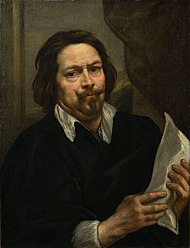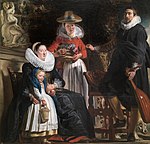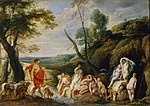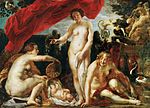Jacob Jordaens
Jacob Jordaens , also Jacob Jordaens the Elder (born May 19, 1593 in Antwerp , † October 18, 1678 ibid) was a Flemish Baroque painter . His teacher was Adam van Noort .
Classification and evaluation
Jacob Jordaens was, alongside Peter Paul Rubens and Anthonis van Dyck, one of the three most important Flemish baroque painters who shaped the 'Antwerp School' in the 17th century.
Even though these Flemish Baroque painters are often compared, all three artists are very different and must be viewed separately as individuals. Rubens was considered a humanist and van Dyck came from a patrician family. Both artists were culturally well-read, had traveled extensively, and spoke multiple languages. Unlike his contemporary colleagues, Jordaens had never traveled abroad to study Italian painting. In contrast to these, Jordaens was considered less tied to court painting. It is often said that his works evade any intellectuality and classical education because of the assignment of his pictures to genre painting . However, this must be contradicted: in fact, Jordaens spent his entire life in Antwerp, apart from a few short trips to rural areas inland or to Holland (The Hague) due to painting commissions - but like Rubens, Jordaens also painted altarpieces, mythological and allegorical scenes. Jordaens was often inspired by Ovid's Metamorphoses , which shows his familiarity with ancient subjects. Not only was Jordaens a successful painter, he was also known for his tapestry designs. After Rubens' death in 1640, Jordaens established himself as the most important artist in Antwerp and was in great demand for many large commissions (including from important courts): in general, the number of his clients increased enormously.
Today Jordaens is known for his large and numerous scenic pictures of genre painting , which are based on the proverbs of his contemporary Jan Brueghel the Elder. Ä. lean on, such as his most famous pictures The King Drinks! and As the old sang, the young whistle. With regard to modern science and new research findings, Jordaens is one of the most important history painters of his time, who was able to deal intellectually with ancient and humanistic images and to link them with a historical image of man. Above all, Jordaens is characterized by the remarkably designed details in his paintings. He was largely under the artistic influence - alongside that of Rubens and the Brueghel family - of northern Italian painters such as Jacopo Bassano , Paolo Veronese and Caravaggio .
Artistic career
Jacob Jordaens was the first of eleven children. His father, who was also called Jacob Jordaens (the Elder), was a successful linen dealer and married to Barbara van Wolschaten. Little can be said about his other siblings: one sister became a nun, two other beguines and one brother entered the Augustinian order as a monk .
Little is known about the childhood and education of young Jordaens, but it can be said that he enjoyed a good education. A good handwriting and extensive knowledge of the French language reflect this, which can be recognized from various private letters. In addition, his pictures show an extensive knowledge of mythological stories. These circumstances suggest a life in the wealthy bourgeoisie. Biblical stories and the subject of religious images were also decisive in Jordaens' work.
Like Rubens, Jordaens studied with the teacher Adam van Noort , who was not an important painter, but distinguished himself as a good teacher, as the later fame of his students shows. Jordaens (who began his apprenticeship as a painter at the age of 14) and the van Noort family not only had a student-master relationship, but also a friendly atmosphere. Later, in 1616, Jordaens even married the eldest daughter Catharina van Noort, with whom he had three children. It is known that Adam van Noort was Jordaens 'only teacher and many pictures of the van Noort family show Jordaens' respect and affection for them. After eight years of apprenticeship, Jordaens was accepted as a master in the Antwerp St. Lucas guild in 1615 , to which van Noort was also a member. In 1621 Jordaens was appointed dean of the indebted Guild of St. Luke by a magistrate's resolution, which Jordaens tried in vain to reject. But the magistrate saw in Jordaens a worthy and talented painter who could get the debt situation under control, and forced him to this position under threat of punishment. Indeed, Jordaens was so successful that by the end of the 1630s he had around sixteen students and assistants under him.
During this time, Jordaens made a name for himself as a waterschilder ( water color painter), which explains his many watercolor paintings on paper, which served as templates for tapestries or etchings. These tapestry designs are considered to be the greatest commissions that Jordaens had in his life. Nevertheless, Jordaens used oil paints in paintings from the very beginning of his career . Over time, Jordaens concentrated more and more on painting with oil colors, which was more profitable. Still, Jordaens had a preference for watercolors and opaque colors, which can be found in many of his paintings.
Jordaens is best known for his genre paintings depicting rural life, but he is less known as a portraitist. Jordaens' motifs and picture themes are often inspired by proverbs. It is noticeable that Jordaens' pictorial themes recur again and again, such as the ancient fable satyr in the farmer's, fertility allegories and bacchanalia.
Many religious and altar paintings are also part of Jordaens' repertoire. Antwerp was a Spanish-occupied area around 1650 and Protestantism was sanctioned, but Jordaens converted publicly and was fined several times for heretical "scandalous" writings. However, this did not prevent Jordaens from accepting orders to decorate Catholic churches in Antwerp. Especially not after Rubens' death, when Jordaens established himself as the most important artist in Antwerp. Thus Jordaens got more and more commissions over time: Not only parishes and smaller towns commissioned him with numerous altarpieces, but also princes and kings of international origin. Although he was less known than court painters such as van Dyck and Rubens, Jordaens received commissions from the English Queen in Greenwich (1639/40) or from Queen Kristina of Sweden (1648).
Jordaens was also supposed to complete the works Rubens had begun after his death in 1640. Nevertheless, under this plethora of orders, Jordaens still found time to make paintings for private customers, so that an unmanageable number of paintings could be attributed to him by the end of his life. With the large number of commissions (he painted up to 35 large-format pictures annually), it is not easy to judge which of these many works came from Jordaens' hand or were produced by his workshop. A statement Jordaens' submitted to a notary after he was charged with forgery said that he had " repainted and altered all [pictures] with his own hands ". However, the help of students was quite common in the workshops for the artistic period in which Jordaens lived.
The wealth of Jordaens, which comes from his family in the cloth goods trade, increased again considerably in addition to the wedding with the wealthy Catharina van Noort and the artistic commissions, which became more and more constant in the art life of Antwerp, ensured the extremely generous financial security of his family . With this, Jordaens not only acquired the house where he was born in Hoogstraat, but also added more houses to his household from the late 1630s to the early 1640s. Jordaens has tackled many decorations around and in the house (such as paintings and ceiling paintings) over the years. With this he built a spacious and representative property, based on the Rubens model. Jordaens lived and worked there until his death in 1678. He died on October 18 of an infectious disease, which at the time was known as the "Antwerp Plague".
Selection of works
Images and information on some works
| image | title | Originated | Size, material | Exhibition / collection / owner |
|---|---|---|---|---|
| The artist with the family of his father-in-law Adam van Noort | around 1615 | 116.3 × 148.2 cm, oil on canvas | Old Masters Picture Gallery (Kassel) in Kassel - Inv. No. GK 107 | |
| The kidnapping of the Europa | 1615 /16 | 273 × 235 cm, oil on canvas | Gemäldegalerie in Berlin | |
| Meleager en Atalanta | around 1618 | 152 × 120 cm, oil on canvas | Royal Museum of Fine Arts , Antwerp | |
| The satyr at the farmer's | around 1620 | 171 × 193.5 cm, oil on canvas | Old Masters Picture Gallery (Kassel) in Kassel - Inv. No. GK 101 | |
| Satyr at the farmer | 1620 /21 | 188.5 × 168 cm, oil on canvas | Royal Museums of Fine Arts in Brussels | |
| The satyr at the farmer's | 1620 /21 | 174 × 204 cm, oil on canvas | Old Pinakothek in Munich | |
| Portrait of a family | to 1621 /22 | 181 × 187 cm, oil on canvas | Museo del Prado in Madrid | |
| Allegory of the fertility of the land | 1623 /25 | 180 × 241 cm, oil on canvas | Royal Museums of Fine Arts in Brussels | |
| Tribute to Ceres | to 1624 /25 | 165 × 112 cm, oil on canvas | Museo del Prado in Madrid | |
| Diana and Actaeon | around 1640 | 54 × 76 cm, oil on panel | Old Masters Picture Gallery in Dresden | |
| The daughters of Kekrops find little Erichthonios | around 1640 | 150 × 208 cm, oil on canvas | Kunsthistorisches Museum in Vienna | |
| The childhood of Jupiter | around 1640 | 219 × 247 cm, oil on canvas | Old Masters Picture Gallery (Kassel) in Kassel - Inv. No. GK 103 | |
| The triumph of Bacchus | 1640 /45 | 205 × 153 cm, oil on canvas | Old Masters Picture Gallery (Kassel) in Kassel - Inv. No. GK 109 | |
| The Festival of the Bean King | 1640 /45 | 242 × 300 cm, oil on canvas | Kunsthistorisches Museum in Vienna | |
| Prometheus bound | around 1642 | 245 × 178 cm, oil on canvas | Wallraf-Richartz-Museum & Fondation Corboud in Cologne | |
| The love of Cupid and Psyche | 1640 /50 | 131 × 127 cm, oil on canvas | Museo del Prado in Madrid | |
| The porridge eater | around 1650 | 191 × 210.5 cm, oil on canvas | Old Masters Picture Gallery (Kassel) in Kassel - Inv. No. GK 105 | |
| Meleager and Atalante | second half of 17th century |
151 × 241 cm, oil on canvas | Museo del Prado in Madrid |
Eponyms
In 1993, on the occasion of his 400th birthday, the asteroid (5232) Jordaens was named after him.
literature
- Jordaens and the ancient world . Musées royaux des Beaux-Arts de Belgique, Brussels, Hessen-Kassel museums. Hirmer Verlag, Munich 2013, ISBN 978-3-7774-2022-6
- Joseph Eduard Wessely : Jordaens, Jacob . In: Allgemeine Deutsche Biographie (ADB). Volume 14, Duncker & Humblot, Leipzig 1881, p. 521 f.
- Felix Billete: On the artistic discussion within the Rubens circle. An investigation using the example of early history paintings by Jacob Jordaens and Anthonis van Dycks . 1993, ISBN 3-631-45875-4
- Roger-Adolf D'Hulst: Jacob Jordaens . 1982, ISBN 3-608-76158-6
- Roger-Adolf D'Hulst: Jacques Jordaens / R.–A. d'Hulst. Translated from the Dutch by Karl Jacquess. Stuttgart 1982.
- Roger-Adolf D'Hulst: Jordaens's Life and Work . In: Jacques Jordaens (1593–1678) . Volume I: Painting and Tapestries . Catalog by R.–A. d'Hulst, Nora de Poorter and Marc Vandenven, ed. by Hans Devisscher and Nora de Poorter, Antwerp Koninklijk Museum voor Schone Kunsten March 27 - June 27, 1993, pp. 23–30.
- Justus Lange [and a.]: Introduction. Jacob Jordaens or Jacques Jordaens (1593–1678) . In: Jordaens and the ancient world , ed. from Mercatorfonds. Brussels [u. a.] 2012, ISBN 3-7774-2022-0 , pp. 9-14.
- Birgit Ulrike Münch, Zita Ágota Pataki (ed.): Jordaens. Genius of Grand Scale - genius of large format , with collabor. v. Elsa Oßwald u. Sarah-Sophie Riedel. Stuttgart 2012, ISBN 978-3-89821-951-8 .
- Kristi Nelson: Jacob Jordaens. Design for tapestry . Brepols Pub 2003, ISBN 2-503-50578-3
- Max Rooses: Jordaens' Leven en Works . 1907. German: Jordaens' life and works . [1908]. The basic work on the Flemish painter with a list of the works.
- Irene Schaudies: Little Latin, even less Greek. Jordaens and the humanistic tradition . In: Jordaens and the ancient world , ed. from Mercatorfonds, Brussels [u. a.] 2012, ISBN 3-7774-2022-0 . Pp. 15-54.
- Martin Warnke: Peter Paul Rubens, Athonis van Dyck and Jacques Jordaens. The three formative painters of the Antwerp Baroque . In: Ortrud Westheider, Michael Philipp: Rubens, van Dyck, Jordaens. Baroque from Antwerp . Hamburg 2010, pp. 23–35.
Web links
- Literature by and about Jacob Jordaens in the catalog of the German National Library
- Works by Jacob Jordaens at Zeno.org .
- Comprehensive section with biography, paintings by the artist, and more.
- Jordaens works in the Gemäldegalerie Alte Meister (Kassel)
Individual evidence
- ↑ Warnke 2010, p. 34.
- ↑ a b c D'Hulst 1993, p. 23.
- ↑ a b Lange 2012, p. 10.
- ↑ a b c d Warnke 2010, p. 32.
- ↑ Schaudies 2012, p. 15.
- ↑ D'Hulst 1982, p. 16 ff.
- ↑ D'Hulst 1982, p. 28.
- ↑ Stefan Whyss: Satyr at the farmer . About ambiguity. March 2002 ( hu-berlin.de [PDF]).
- ↑ a b D'Hulst 1982, p. 33.
- ↑ D'Hulst 1982, p. 26.
- ↑ D'Hulst 1982, p. 30.
- ↑ D'Hulst 1982, p. 37.
| personal data | |
|---|---|
| SURNAME | Jordaens, Jacob |
| ALTERNATIVE NAMES | Jordaens, Jacques |
| BRIEF DESCRIPTION | Flemish painter |
| DATE OF BIRTH | May 19, 1593 |
| PLACE OF BIRTH | Antwerp |
| DATE OF DEATH | October 18, 1678 |
| Place of death | Antwerp |




















